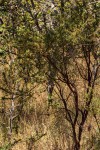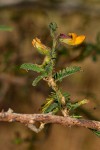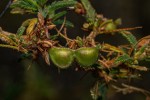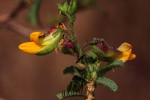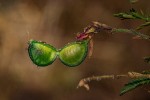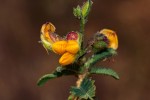Aeschynomene nyikensis
Selected images: Click on each image to see a larger version and details of the record View all images (7)
Detailed records: Display species records QDS maps by: Google Maps Point records by Google Maps
Species details: Click on each item to see an explanation of that item (Note: opens a new window)
| Synonyms: | |
| Common names: | |
| Frequency: | |
| Status: | Native |
| Description: |
Erect branched shrub, up to c. 3 m tall. Stems covered with viscid tubercular-based hairs when young, sometimes peeling to leave a roughened surface. Leaves fasciculate, 18–26(–40)-foliolate; leaflets linear-oblong, 1.5–3.5 mm long, rather thick, imbricated, pubescent or hairless; petiole and rhachis together up to 8 mm long; stipules lanceolate, 3 mm long. Inflorescences axillary, together usually forming a terminal panicle; rhachis 1.5–5 cm long; peduncle 0.3–1.2 cm long; pedicels 3 mm long; bracts ovate, 3.5 mm long, bifid, striate, pubescent, soon deciduous; bracteoles lanceolate, 5.5 mm long, ciliolate, eventually deciduous. Calyx slightly pubescent, 2-lipped; lips ovate or oblong, 7–10 mm long, one slightly to deeply emarginate, the other slightly trifid. Standard yellow or orange, sometimes lined with purple or red, 1.2–1.5 cm long; wings yellow or orange; keel-petals green or yellow, not laciniate. Pods of 1 or 2 articles joined by a narrow neck; articles elliptic, with upper edge almost straight and lower edge strongly curved, 7.5–10 mm long and 5.6–7 mm wide, compressed with thickened margins, hairless but later minutely verruculose. |
| Type location: |
Malawi |
| Notes: | |
| Derivation of specific name: | nyikensis: of the Nyika Plateau, where the type specimen was collected. |
| Habitat: | In and at the edges of Brachystegia woodland, sometimes along margins of marshland. |
| Altitude range: (metres) | 1200 - 2250 m |
| Flowering time: | |
| Worldwide distribution: | Southern Tanzania and Malawi. |
| FZ divisions: | N,C,S |
| Growth form(s): | |
| Endemic status: | Near Endemic |
| Red data list status: | |
| Insects associated with this species: | |
| Spot characters: | Display spot characters for this species |
| Images last updated: | Saturday 22 October 2022 |
| Literature: |
Burrows, J.E. & Willis, C.K. (eds) (2005). Plants of the Nyika Plateau Southern African Botanical Diversity Network Report No. 31 SABONET, Pretoria Page 151. Verdcourt, B. (2000). Papilionoideae Flora Zambesiaca 3(6) Page 103. |
Other sources of information about Aeschynomene nyikensis:
External websites:
African Plants: A Photo Guide (Senckenberg): Aeschynomene nyikensisAfrican Plant Database: Aeschynomene nyikensis
BHL (Biodiversity Heritage Library): Aeschynomene nyikensis
EOL (Encyclopedia of Life): Aeschynomene nyikensis
GBIF (Global Biodiversity Information Facility): Aeschynomene nyikensis
Google: Web - Images - Scholar
iNaturalist: Aeschynomene nyikensis
IPNI (International Plant Names Index): Aeschynomene nyikensis
JSTOR Plant Science: Aeschynomene nyikensis
Mansfeld World Database of Agricultural and Horticultural Crops: Aeschynomene nyikensis
Plants of the World Online: Aeschynomene nyikensis
Tropicos: Aeschynomene nyikensis
Wikipedia: Aeschynomene nyikensis
